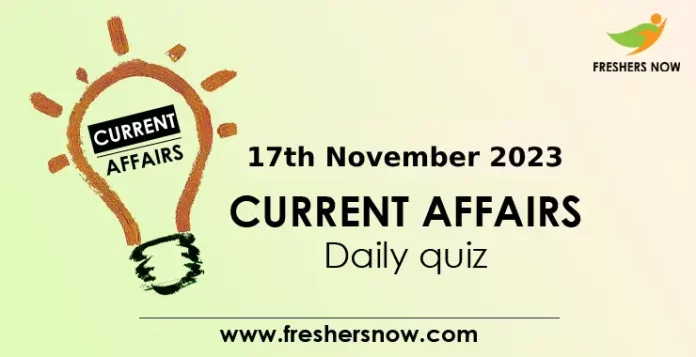
17th November 2023 Current Affairs Quiz: Welcome to the Current Affairs Quiz for 17th November 2023! Stay informed and test your knowledge on the latest events and developments around the world. In this quiz, we’ll cover a range of topics from politics and economics to technology and global affairs. Challenge yourself with questions that reflect the current happenings on this significant date. It’s an excellent opportunity to stay updated and gauge your awareness of the world’s dynamic landscape. Let’s dive into the quiz and see how well you’ve been keeping up with the 17th November 2023 current affairs!
17th November 2023 Current Affairs | Today GK Quiz
1. What is the percentage reduction in the Special Additional Excise Duty (SAED) on crude oil imports announced by the Indian government?
A) 20%
B) 35.71%
C) 50%
D) 75%
Answer: B) 35.71%
Explanation: The SAED on crude oil imports has been reduced by 35.71%, from Rs. 9,800 per tonne to Rs. 6,300 per tonne.
2. When does the new tax structure, as per the recent adjustments, come into effect?
A) November 1, 2023
B) November 16, 2023
C) December 1, 2023
D) January 1, 2024
Answer: B) November 16, 2023
Explanation: The new tax structure is set to come into effect from November 16, 2023, until the announcement of the next adjustment.
3. What is the purpose of Google’s ‘double-check’ response feature in the AI chatbot Bard?
A) It allows users to customize their chatbot experience.
B) It prevents the chatbot from responding to fact-based queries.
C) It adds an extra layer of reliability to information provided by Bard.
D) It limits the access of Bard based on regional regulations.
Answer: C) It adds an extra layer of reliability to information provided by Bard.
Explanation: The ‘double-check’ response feature in Bard is implemented to enhance the accuracy of information provided by the chatbot, ensuring a higher level of reliability, especially when handling fact-based queries.
4. What does the AI literacy guide and on-boarding video introduced by Google aim to achieve for teen users?
A) Limit the accessibility of Bard based on regional regulations.
B) Provide step-by-step explanations of mathematical concepts.
C) Familiarize users with Bard’s underlying technology and encourage a critical understanding of generative AI tools.
D) Implement age restrictions for managing a Google Account.
Answer: C) Familiarize users with Bard’s underlying technology and encourage a critical understanding of generative AI tools.
Explanation: The AI literacy guide and on-boarding video introduced by Google aim to familiarize teen users with Bard’s underlying technology and encourage a critical understanding of generative AI tools.
5. What was one of the key areas of concern highlighted by the RBI regarding Axis Bank’s non-compliance?
A) Failure to record customer calls.
B) Persistent customer calls.
C) Lack of recovery agents.
D) Lack of customer declarations.
Answer: B) Persistent customer calls.
Explanation: The RBI expressed concern about Axis Bank’s persistent calls to some customers, emphasizing the breach not only raised privacy concerns but also indicated a failure to adhere to prescribed guidelines.
6. What crucial lapse in procedural adherence was identified by the RBI in relation to Axis Bank’s non-compliance?
A) Failure to record customer calls.
B) Lack of recovery agents.
C) Failure to obtain customer declarations.
D) Violation of KYC Directions.
Answer: C) Failure to obtain customer declarations.
Explanation: The RBI identified Axis Bank’s failure to obtain declarations from customers at the time of opening current accounts as a crucial lapse, indicating a procedural adherence gap and potential issues in customer documentation.
7. What is identified as the primary challenge to achieving the 4% Consumer Price Index (CPI) target by the Reserve Bank of India (RBI)?
A) Global economic landscape.
B) Escalating global risks.
C) Rising food prices.
D) Real GDP growth.
Answer: C) Rising food prices.
Explanation: The RBI identifies rising food prices, specifically in essential items like onions, tomatoes, cereals, pulses, and sugar, as the primary challenge to achieving the 4% Consumer Price Index (CPI) target.
8. What is the percentage weight of food items in the CPI basket, as highlighted in the RBI report?
A) 20%
B) 30%
C) 40%
D) 50%
Answer: C) 40%
Explanation: Food items carry a significant weight of approximately 40% in the CPI basket, making them a crucial factor in determining overall inflation, as emphasized in the RBI report.
9. What is the estimated annual GDP growth range forecasted by S&P Global for India from FY24 through FY26?
A) 4-5%
B) 5-6%
C) 6-7.1%
D) 7-8%
Answer: C) 6-7.1%
Explanation: S&P Global forecasts a robust economic growth for India, estimating a GDP expansion ranging between 6 to 7.1 percent annually from FY24 through FY26.
10. What factor contributes to the decline in weak loans in the Indian banking sector, according to the S&P Global report?
A) Increase in external demand.
B) Unhealthy corporate balance sheets.
C) Structural enhancements and improved risk-management practices.
D) Higher interest rates.
Answer: C) Structural enhancements and improved risk-management practices.
Explanation: S&P Global anticipates a decline in weak loans in the banking sector, attributing this positive shift to structural enhancements, including healthier corporate balance sheets, tightened underwriting standards, and improved risk-management practices.
★★ You Can Also Check ★★



